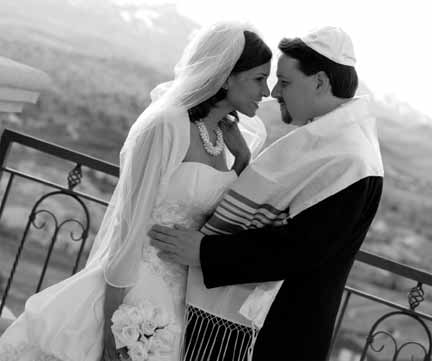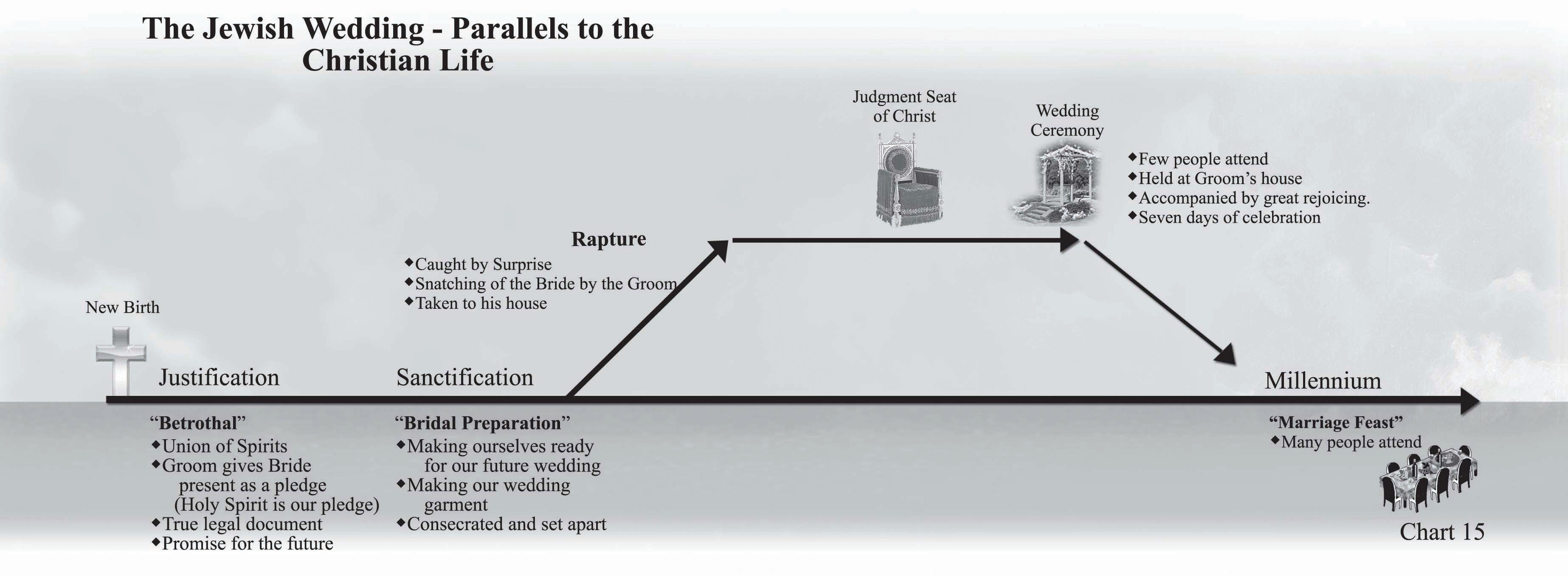For the last several months, we have concentrated on the Judgment Seat of Christ (the Bema Seat as it is often called) and learned what it is, what happens there and what some of the rewards are that will be handed out. The next event that occurs in heaven is the gathering of the “bride” to attend the Marriage Ceremony itself (Rev 19:7-8).
The Marriage Ceremony is an area that is not well trodden, so be as the Bereans—get into the Word and check out everything that is shared (Acts 17:11).
The word marriage in the Greek is gamos (Strong’s #1062), and can mean either a “wedding ceremony” or a “wedding feast.” This is where the confusion often comes in. In other words, the word gamos can be used for either the “wedding ceremony” itself or for the “wedding feast” which happens at a later date. In a moment we’ll explore the entire Jewish wedding celebration, which hopefully will help to clear up some of the confusion.
I believe the sequence of future events that will occur after the Bema Judgment Seat of Christ are:
1) The Wedding Ceremony (or the Marriage of the Lamb), which will occur in the Father’s house in heaven with only a few in attendance (Revelation 19:7-9).
2) This event is then followed by Christ’s return to earth with His wife.
3) And finally, the Marriage Feast (or the Marriage Supper), which will be held on earth with many in attendance just as the Millennium begins. The Marriage Supper includes “the friends of the Groom” (i.e. John the Baptist and other Old Testament saints) who are not resurrected until after His Second Coming (John 3:29).
Those believers whose “works” pass the Bema Seat Judgment criteria and who are deemed ready, worthy and prepared will obviously attend both the Wedding Ceremony in heaven and the Marriage Feast on earth that follows.
It will be the highest honor possible to be a part of the “wife of Christ” (Revelation 19:7), but also an honor to be one of the King’s guests at the Marriage Feast (Matthew 22:1–14; 25:1–13).
The Jewish Wedding Ceremony
 To help us understand the sequence of these future events a little more clearly, let’s describe the ancient Jewish marriage ceremony, as this is the model that Christ uses.
To help us understand the sequence of these future events a little more clearly, let’s describe the ancient Jewish marriage ceremony, as this is the model that Christ uses.
There are many parallels in the Bible to various events in a believer’s life, but none more visible than the similarity between the Christian life and that of a Jewish marriage ceremony.
In the Old Testament, the parents normally arranged the marriage between the young Jewish couple. Romantic unions, in those days, were uncommon. This arranged “marriage” consisted of three parts:
1) The first part of the Jewish wedding ceremony was the betrothal, which was called the erusin or the kiddashin.
This is where the groom gave his bride-to-be an object of value such as a ring, money, or a deed of intention, which was symbolic of a promise providing a legal tie between the two.
The father of the groom usually paid the bridal price. This was a true legal document, having no immediate effect on their personal stake, but just a promise for the future. (Deuteronomy 20:7)
After this ceremony, the “bride” then remained in her father’s home to prepare for the day her groom would come back for her, marry her and take her to his house or some special room he had built.
Cohabitation was forbidden at this time and the bride must remain a virgin, using this time to prepare herself for her marriage. If she was found not to be a virgin, she could be rejected. (Matthew 1:19)
This in-between time was where the bride must make herself ready for her coming groom. (Revelation 19:7) This preparation meant making her own wedding gown, getting ready for her new role, transferring her allegiance from her father to her new husband, going from the familiar to the unfamiliar, from depending on family to depending upon her husband for everything, learning to love him, and setting her mind on how to please him.
During this “preparation period,” the bride is referred to as “consecrated,” or set apart (or sanctified). She always wore a veil, so it was apparent to others that she was engaged. This veil was symbolic of a pledge or a commitment.
2) The second part of the Jewish marriage was called the nissuin or the marriage ceremony itself. The groom often surprised his bride by his unexpected or early return.
All Jewish brides were said to be “stolen, caught up, or snatched up by surprise.” The bride was then led to the groom’s house by a wedding procession of women carrying lighted lamps, similar to the Parable of the Ten Virgins that we will explore in next month’s Personal Update.
Lamps were a part of the bride’s preparation in case her groom came at night. The bride was arrayed in fine linen, clean and white.
The wedding ceremony itself was held at the groom’s father’s house and usually included only a few invited guests. At this time a series of benedictions are made and the couple were finally made husband and wife.
3) The wedding ceremony was then followed by seven days of celebration, great rejoicing, and finally, a marriage feast. This occasion was often held at a different place and many people were invited.

Now that we understand a little more about the Jewish marriage celebration, let’s compare this ceremony to the Christian life.
1) The salvation of our spirit (called justification) with the seal of the Holy Spirit, I believe is analogous to the betrothal of the Jewish bride with the down payment, pledge, or seal of “an object of value” (Ephesians 1:13; 4:30 ).
Hosea 2:19-20 puts it this way: “I will betroth thee unto Me forever; yea, I will betroth thee unto Me in righteousness, and in justice, and in loving-kindness, and in mercies. I will even betroth thee unto Me in faithfulness; and thou shalt know the Lord” (2 Corinthians 11:2). The process of sanctification that we are all in now as we wait for our Lord’s return, can be compared to the long wait between the time the groom leaves to prepare a place for his bride and the time he returns for her.
Note the importance placed upon the Jewish bride during this waiting period to prepare herself for her groom’s return—to make her own gown and her own wedding garment, which we see as “the righteousness of the saints” (i.e., bearing “spiritual fruit.” (Revelation 19:7) This stresses the significance of the sanctification process––our time of preparation, our time of fitting, and our time of making ourselves ready, worthy, and qualified for our Groom’s return.
Sanctification, again, is our bridal preparation! It’s getting ourselves ready for our coming new role: transferring our allegiance from earthly things to heavenly things; learning to love God rather than self; replacing our preoccupation with our friends and families to making the Lord and His will the most important thing in our lives; and finally, going from depending upon self (and our own abilities) to depending upon Christ for everything.
The bride of Christ must make herself “ready” so she can be presented to the Lord without stain or wrinkle. (Ephesians 5:27)
2) The second part of the Jewish marriage ceremony—the nissiun (or marriage ceremony itself—where the Jewish groom surprises his bride by coming back early for her, I believe could be compared to the unexpected return of our Lord at the Rapture (1 Thessalonians 4:13–18).
As we said, the procession of women carrying lighted lamps to meet the groom when he returns re-minds us of the Parable of the Ten Virgins. The five wise virgins, whose lamps were still burning when the groom returned, were ready and prepared to go into the wedding ceremony; the other five virgins were not prepared and thus, were not allowed to enter.
The Jewish wedding ceremony that was held in the groom’s house is analogous to the Marriage of the Lamb in heaven, where Christ will finally be united with His bride and she will become His wife.
3) The seven days of Jewish celebration and rejoicing between the wedding ceremony itself and the marriage feast, may be analogous to the rejoicing that will occur first in heaven at the wedding and then at the Marriage Supper on earth where Christ will again drink of the “fruit of the vine” (Revelation 19:9). Many resurrected Old Testament saints and Tribulation saints will also attend this feast on earth.
In summary: As Christians, our initial commitment to the Lord and our “justification” by Him can be compared to the Jewish betrothal. Our “sanctification,” then, can be compared to a Jewish woman preparing herself for her future wedding. Our “glorification” (which happens at the Rapture) can be compared to a Jewish groom coming by surprise to carry his bride away.
The Marriage of the Lamb in heaven can be compared to the Jewish wedding ceremony itself. And the Marriage Feast at the beginning of the Millennium can be compared to the Jewish marriage supper.
Do not think for a moment that God has not already planned and designed our future destiny in minute detail. He has! Look at the above incredible example. His intentions are clear and His strategy is discernible. I believe this Jewish wedding celebration is one of the most impressive indications of what exactly we, as believers, are supposed to be doing now in this lifetime and what we can expect in the near future when He returns for us and takes us to His home in heaven.
Can you even imagine what that will be like!!!
“Eye hath not seen, nor ear heard, neither have entered into the heart of man, the things which God hath prepared for them that love (agapao) Him.” (1 Corinthians 2:9)
To be continued next month: “The Parable of the Ten Virgins.” This article has been excerpted, in part, from Chuck and Nan’s new book The Kingdom, Power and Glory.





